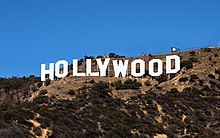American movies
| Cinema of the United States | |
|---|---|

The Hollywood Sign in Hollywood, Los Angeles, California, often regarded as a symbol of the American film industry.
|
|
| No. of screens | 40,547 (2015) |
| • Per capita | 14 per 100,000 (2015) |
| Main distributors |
Paramount (19.2%) Warner Bros. (18.0%) Sony Pictures (12.5%) |
| Produced feature films (2013) | |
| Fictional | 727 (98.5%) |
| Animated | 11 (1.5%) |
| Number of admissions (2015) | |
| Total | 1,197,000,000 |
| • Per capita | 3.9 (2010) |
| Gross box office (2015) | |
| Total | $10.1 billion |
The cinema of the United States, often metonymously referred to as Hollywood, has had a profound effect on cinema across the world since the early 20th century. The dominant style of American cinema is Classical Hollywood Cinema, which developed from 1917–1960 and characterizes most films to this day. While Auguste and Louis Lumière are generally credited with the birth of modern cinema, it is American cinema that soon became the most dominant force in an emerging industry. Since the 1920s, the American film industry has grossed more money every year than that of any other country.. It also produces the largest number of films of any single language (English) with more than 800 movies released out every year.
Hollywood is the oldest film industry of the world, and birthplace of various genre of cinema such as comedy, drama, action, musicals, romance, horror, science fiction and war epics, which later inspired other film industries in the world. It also produced the world’s first sound as well as musical film The Jazz Singer.
In 1878, Eadweard Muybridge demonstrated the power of photography to capture motion. In 1894, the world's first commercial motion picture exhibition was given in New York City, using Thomas Edison's Kinetoscope. The United States was in the forefront of sound film development in the following decades. Since the early 20th century, the U.S. film industry has largely been based in and around the 30 Mile Zone in Hollywood, Los Angeles, California. Director D. W. Griffith was central to the development of film grammar. Orson Welles's Citizen Kane (1941) is frequently cited in critics' polls as the greatest film of all time.
...
Wikipedia
